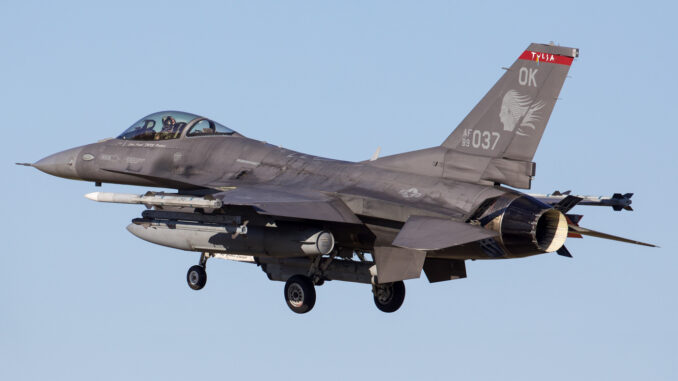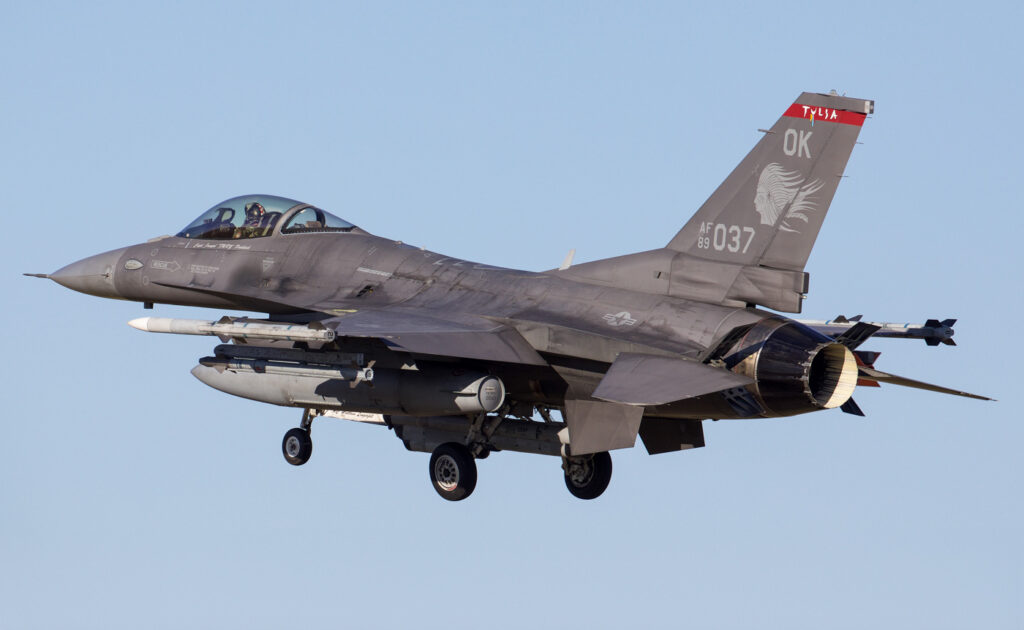
The AN/ALQ-257, the F-16’s new electronic warfare system, aims to improve survivability in contested electromagnetic environments.
The new AN/ALQ-257 electronic warfare system fitted to the F-16 Block 50 is entering the flight test phase following successful tests in an anechoic chamber. The system, called the Integrated Viper Electronic Warfare Suite (IVEWS), is designed to detect, identify and counter advanced radio frequency threats on the battlefield. Designed to provide capabilities comparable to those of fifth-generation aircraft, IVEWS enhances the survivability of the aircraft in dense and contested operating environments. Tested for the past three years, the IVEWS is on the verge of entering service, with production scheduled for 2025.
AN/ALQ-257: an advanced electronic warfare system for the F-16
The F-16 Fighting Falcon, one of the world’s most widely used fighter aircraft, is undergoing major upgrades to remain competitive in the face of modern threats. The latest addition to its capabilities is the AN/ALQ-257, a fully digital electronic warfare system designed by Northrop Grumman. This system is part of the Integrated Viper Electronic Warfare Suite (IVEWS), designed to provide the F-16 with increased protection against advanced electromagnetic threats.
The IVEWS recently completed ground trials in an anechoic chamber, where it was tested against complex simulations of the radio frequency spectrum. The aim of these tests was to validate the system’s ability to detect, identify and counter modern threats, such as anti-aircraft radars and missiles. One of the strengths of this system is its ultra-wideband sensor, which enables it to cover a wide range of frequencies, including millimetre-wave systems.
The transition from chamber tests to flight tests is a critical stage in the development of the IVEWS, which has already begun on a F-16 Block 50. According to James Conroy, vice-president of navigation, targeting and survivability at Northrop Grumman, the flight tests will last a few weeks and will validate the results obtained during the laboratory tests. An operational evaluation is scheduled for the fourth quarter of 2024, and production could begin as early as 2025 if the tests are conclusive.
Advantages of the IVEWS system: towards a fifth-generation capability
The IVEWS is designed to provide capabilities comparable to those of fifth generation aircraft, such as the F-35. The integration of this system will enable the F-16 to remain relevant in the face of increasingly complex threats. Unlike the previous AN/ALQ-131 system, a pod mounted on the centreline of the F-16, the IVEWS is fully integrated into the aircraft, freeing up a carry point for an additional weapon or fuel tank.
This integration results in improved stealth and aircraft efficiency, as the IVEWS uses antennas located elsewhere on the fuselage of the F-16, without altering its external shape. This approach maintains the aircraft’s aerodynamic performance while increasing its ability to counter electromagnetic threats.
The IVEWS also offers the possibility of accurately geolocating** threat emitters with a single aircraft, which is essential in missions where mobile anti-aircraft radars can change position. This real-time threat localisation and neutralisation capability significantly improves the F-16’s survivability during operations in dense and contested electromagnetic environments.
In addition, IVEWS is designed to work in conjunction with the AN/APG-83 SABR radar, an Active Electronically Scanned Array (AESA) radar recently installed on the F-16. Together, these two systems enable the aircraft to detect, track and attack targets while remaining protected against electromagnetic threats.

Flight testing and validation: a crucial phase for the IVEWS
Flight testing of the IVEWS is essential to validate its effectiveness in real-life situations. The aim is to reproduce in flight the performance observed during anechoic chamber tests and to ensure compatibility with the F-16’s other on-board systems. The system has already been tested in a variety of ground conditions, including military exercises such as Northern Lightning 2021, where it was mounted on a Bombardier CRJ aircraft used as a test bed.
These ground tests demonstrated the system’s ability to detect and neutralise electromagnetic threats in a simulated environment. However, flight tests are necessary to assess its behaviour in real-life situations, particularly when confronted with radars and mobile anti-aircraft systems that may switch on their systems in the immediate vicinity of the aircraft. According to Conroy, these tests will be carried out on two F-16s, and the results will determine the system’s ability to be deployed in operations by 2025.
The transition from laboratory to flight testing is a crucial phase in the development of any electronic warfare system. By flying in real environments, the IVEWS-equipped F-16 will be confronted with practical challenges such as managing multiple threats simultaneously, compatibility with other on-board systems and resistance to electromagnetic interference.
Strategic and international implications of the IVEWS system
The integration of the IVEWS system into the US Air Force’s F-16s has major strategic implications. The F-16, which is in service in more than 25 countries, remains one of the most versatile fighter aircraft in the world. With more than 4,500 units produced** since its introduction in the 1970s, the addition of the IVEWS means that this aircraft will remain operational until the 2040s.
The system is particularly relevant for air forces operating in contested electromagnetic environments, where mobile anti-aircraft radars and missiles can pose a major threat. By providing the F-16 with fifth-generation electronic warfare capabilities, the IVEWS improves pilot survivability and enables safer operations in high-threat areas.
IVEWS is also being evaluated by a number of international F-16 users, in particular those who have ordered F-16 Block 70, the latest version of the aircraft. Countries such as Turkey have already signed a letter of intent to integrate IVEWS into their Block 70 fleet, demonstrating the international interest in this system. Other countries could follow suit, strengthening the F-16’s appeal on the world market in the face of more recent, but more expensive, aircraft such as the F-35.
A leap forward for the survival of the F-16
The development of the AN/ALQ-257 IVEWS for the F-16 represents a technological leap in the aircraft’s ability to survive in modern and contested environments. By offering electronic warfare capabilities comparable to those of fifth-generation aircraft, this system will ensure the F-16’s operational relevance for decades to come.
With flight tests underway and an operational evaluation scheduled by the end of 2024, the IVEWS could be fully operational by 2025, marking another step in the modernisation of one of the world’s most widely used fighters. As electromagnetic threats become more sophisticated, the IVEWS is positioning itself as a crucial asset for air forces wishing to enhance their survivability and mission effectiveness.
War Wings Daily is an independant magazine.